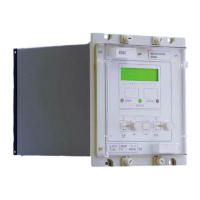Manual
KVCG202/EN M/H
compensation on the relay to correct for the additional error that would occur because of
this. This is shown in Figure 18. In this example Vr is set to:
Vr =
3 x Ip x XT tan φ
VT_ratio
where Cosϕ = power factor of the load
Figure 18: Negative reactance control at non unity power factor
As previously described Figures 15 and 16 show the use of negative reactance control
where line drop compensation is also being used. Because the reactive setting, Vxl, is
based on the transformer reactance and not the line reactance a small error is introduced
at unity power factor currents. If the power factor is decreased this error will increase. It
is possible to increase the resistive compensation setting to help decrease this error.
However, the resultant error can still be significant at low power factors. Figure 19
demonstrates this. In this example Vr is set to:
Vr =
3 x IP x (RL + (XL + XT) tan φ)
VT_ratio
Figure 19: Low power factor with negative reactance control and LDC 1
There is a feature included within the KVGC to overcome the effect of a system with a
low power factor. The feature alters the angle between the resistive and reactive
compensation. This angle is nominally 90° however by setting it to (90 - θ)° the error can
be reduced, see Figure 20. In the KVGC settings the power factor angle θ° is set which
alters the angle between the resistive and reactive compensation to (90 - θ)°. Note, the
power factor angle setting θ is only visible when Vxl is set negative. In this example Vr is
set to:

